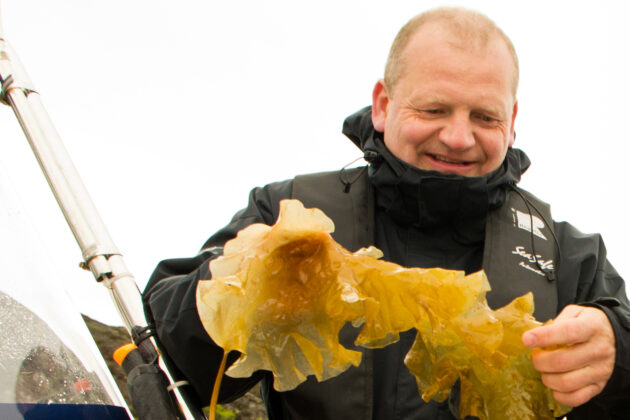Kelp – an important source of vital iodine

Iodine. A chemical element. An important ingredient in food. All people need it to avoid serious illness. The problem is that we consume less of the fish, milk and salt that contains this important substance. So what should we do?
This is when an old familiar acquaintance from the sea enters the stage: Kelp.
“If we don’t get enough iodine, we get sick. However, consumption of the food products that contain the most iodine is decreasing. Struma, a common deficiency disease in the 1930s, is experiencing a resurge which is causing concern among the health authorities. This is why initiatives to introduce more kelp in our diets are very interesting”, says Senior Scientist Dagbjørn Skipnes at Nofima.
One of the world’s largest renewable biomasses
Macroalgae seaweed and kelp, one of the world’s largest renewable biomasses, are found in huge quantities – and many different species – along the entire Norwegian coast. Seaweed and kelp contain minerals, vitamins and fibre. They can be used as a thickening agent, flavour enhancer and salt substitute, and have been used in food since the Viking Age.
In the 1930s, times were tough economically in Norway, and finding alternative food sources was a necessity. Along the coast, the ubiquitous kelp was used as a food source for both humans and animals, and several research communities conducted research on this algae. Then the war came, and kelp disappeared from the spotlight for various reasons. It was not until the 1970s that the interest in this nutrient-rich algae picked up again. In Asia, kelp is already big business, and several Norwegian research communities and food manufacturers are now once again busy with mapping its different areas of use and using it as a resource for creating new products.
“In the 1930s, kelp was dried, ground and mixed into bread flour. From the 70’s onwards, the valuable substance alginate has been manufactured from algae. And today, an increasing number of products that contain kelp are being made”, says Skipnes.
Alginate is extracted from kelp and seaweed. It has thickening, gelatinous and stabilising properties, and is therefore used extensively in the food industry – and for various imprint media used to, for example, make dentures. The substance is also used in the pharmaceutical industry, among other things to relieve diabetes-related ailments.
Kelp and seaweed in a modern diet
However, it is the use of kelp in a modern diet Dagbjørn Skipnes and his Nofima colleagues wish to study further. As part of Nofima’s strategic initiative TastyKelp, scientists are working to acquire expertise in sustainable value creation from kelp and seaweed.
“The aim of the TastyKelp project is to make safe and high-quality food products from the kelp, where iodine is a key element,” says Skipnes.
Many in Norway have encountered seaweed and kelp in sushi in recent years. And if kelp and seaweed are added to fish cakes and other processed products, it can help increase the fibre content. It was in fact a sugar kelp enhanced fish burger that landed the fast-food establishment Patricias Gatekjøkken in Bardu, Troms the award for Norway’s best healthy fast food in 2018. The burger was developed in collaboration with Nofima, among others.
Other products that are already in the shops or under development include snacks, health foods, spices and various convenience food products such as powdered soup.
Key word: Iodine content
The most commonly cultivated kelps in Norway are sugar kelp, winged kelp, red dulse (also known as “the bacon of the sea” and “sea truffle” seaweed.
“The iodine content of these kelp species varies by season, species and where they are grown – and what part of the macroalgae is used. A kelp blade can be two and a half meters long, and the iodine content is not the same at the tip and at the stalk,” explains Dagbjørn Skipnes.
Iodine content is key throughout all the research on kelp. Too little is detrimental to human health, but too much is just as bad. There are therefore strict regulations in place for how much iodine a food product can contain.
“The Norwegian Institute of Public Health has recommended a daily intake of at least 150 micrograms of iodine, while the Norwegian Food Safety Authority recommends that the upper limit in Norway is 600 micrograms per day,” says Dagbjørn Skipnes.
That’s not a lot in terms of physical quantity: A microgram is a millionth of a gram.
By comparison, Japan, which uses a great deal of kelp for sushi, has an upper recommended limit of 2,000 micrograms per person per day.

“Kelp can contain up to 3000 micrograms per gram of dried raw material – meaning a single gram will contain iodine far exceeding the recommended daily dose. However, the concentration is only one-tenth of that when the kelp is raw, and it loses up to 90 per cent of its iodine content when it is heat treated, for example by boiling it”, explains the kelp scientist.
The same process also reduces the amount of harmful heavy metals in the kelp.
Manufacturers ensure that the iodine content of the products that are introduced to the market is within the recommended limits.
“Dried winged kelp currently contains approximately 20 micrograms of iodine per gram. When potato chips manufacturer Sørlandschips launched kelp-flavoured chips, only a few grams of dried kelp are used to add flavour to each bag”, says Skipnes.
He adds that people with a proven iodine deficiency should increase their intake cautiously in consultation with a doctor.
“Shock therapy with kelp is probably not recommended”, says the Nofima scientist.
Many possibilities
So what opportunities are there for kelp in a modern diet?
“They are vast and plentiful”, says Dagbjørn Skipnes, and elaborates:

“’The blue harvest grounds’ – the sea – covers two-thirds of the globe. Only six per cent of it is used for food production. There is a great need for more cultivated food from the sea, and the opportunities to grow a lot of food to feed many people are vast. We are now working to identify the right species for this. We don’t know yet what species will become most useful, but what we do know is that kelp is one of them. The kelp can become food both directly and indirectly – for example as fodder for sea urchins or as a component in animal feed, the kelp expert explains.
Kelp can also bind large amounts of CO2, and it does not need fertilizer, agricultural land or freshwater to grow.
“Together with the food industry, we will therefore continue to work on developing new food products with kelp and adding new components of kelp to health products. We will also investigate further what happens to the iodine content in the kelp when it is processed – for example when it is boiled, fried, rinsed, dried or fermented. The possibilities are vast for this useful plant”, concludes Dagbjørn Skipnes.
Facts about iodine
- In addition to being a chemical element, iodine is a nutrient that must be supplied via the diet.
- Iodine deficiency is very prevalent worldwide because soils, agricultural products and drinking water have a highly varying iodine content across different parts of the world.
- Iodine has only one function in the body, and that is to work with the metabolism hormones thyroxine (T4) and triiodothyronine (T3) which are produced in the thyroid gland (thyroidea).
- If you develop an iodine deficiency, the thyroid gland can grow in size to compensate for the deficiency. In case of moderate to severe iodine deficiency, the gland can become so large that it becomes visible at the base of the throat. An enlarged thyroid gland is called a goiter.
- Women of childbearing age, the elderly, vegetarians, vegans and others who drink little milk and eat little white saltwater fish are prone to iodine deficiency.
- Iodine deficiency is particularly worrisome in women of childbearing age and in pregnant women, as the foetus needs iodine for brain development.
- Iodine supplements are recommended for those who get too little iodine.
Source: Norwegian Institute of Public Health
Contact person
Topics
Low trophic species

